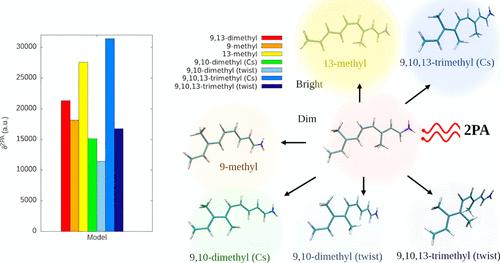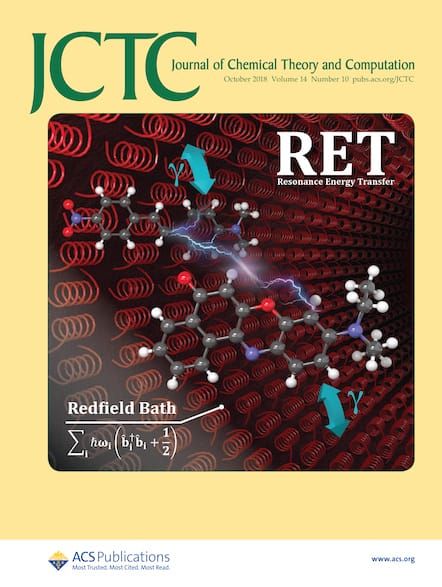Tuning Two-Photon Absorption in Rhodopsin Chromophore via Backbone Modification: The Story Told by CC2 and TD-DFT
IF 5.5
1区 化学
Q2 CHEMISTRY, PHYSICAL
引用次数: 0
Abstract
We investigate here a systematic way to tune two-photon transition strengths (δ2PA) and two-photon absorption (2PA) cross sections (σ2PA) of the rhodopsin’s chromophore 11-cis-retinal protonated Schiff base (RPSB) via the modulation of the methyl groups pattern along its polyene chain. Our team employed the resolution of identity, coupled cluster approximate second order (RI-CC2) method with Dunning’s aug-cc-pVDZ basis set, to determine the structural impact on δ2PA, as well as its correlation to both transition dipole moments and permanent electric dipole moments. Seven structures were probed in vacuo, including five-double-bond-conjugated model of the native chromophore, shortened by the β-ionone ring (RPSB5), and its de/methylated analogues: 9-methyl, 13-methyl, planar and twisted models of 9,10-dimethyl and 9,10,13-trimethyl. Our results demonstrate that the magnitude of δ2PA is dictated by both the position and number of methylated groups attached to its polyene chain as well as the degree of dihedral twist that is introduced due to the de/methylation. In fact, a strong correlation between δ2PA enhancement and the presence of a C13-methyl group in the planar RPSB5 species is found. Trends in δ2PA values follow the trends observed in their corresponding changes in the permanent dipole moment upon the S0–S1 excitation nearly exactly. The assessment of four DFT functionals, i.e., M11, MN15, CAM-B3LYP, and BHandHLYP, previously found most successful in predicting 2PA properties in biological chromophores, points to a long-range-corrected hybrid meta-GGA M11 as the top-performing functional, albeit still delivering underestimated δ2PA and σ2PA values by a factor of 3.3–5.3 with respect to the CC2 results. In the case of global-hybrid meta-NGA (MN15), as well as CAM-B3LYP and BHandHLYP functionals, this factor deteriorates significantly to 6.7–20.9 and is mostly related to significantly lower quality of the ground- and excited-state dipole moments.

通过骨架修饰调谐 Rhodopsin 发色团的双光子吸收:CC2 和 TD-DFT 讲述的故事
我们在此研究了一种系统的方法,即通过调节沿多烯链的甲基基团模式,来调整视紫红质发色团 11-顺式视紫红质质子化席夫碱(RPSB)的双光子转换强度(δ2PA)和双光子吸收(2PA)截面(σ2PA)。我们的研究小组采用了特征解析、耦合簇近似二阶(RI-CC2)方法和 Dunning 的 aug-cc-pVDZ 基集,以确定结构对 δ2PA 的影响,以及它与过渡偶极矩和永久电偶极矩的相关性。对七种结构进行了空位探测,其中包括原生发色团的五双键共轭模型、由 β-ionone 环缩短的模型(RPSB5)及其脱/甲基化类似物:9-甲基、13-甲基、9,10-二甲基和 9,10,13-三甲基的平面和扭曲模型。我们的研究结果表明,δ2PA 的大小取决于附着在其聚烯链上的甲基化基团的位置和数量,以及由于脱/甲基化而引入的二面扭曲程度。事实上,在平面 RPSB5 物种中,δ2PA 的增强与 C13 甲基的存在之间存在很强的相关性。在 S0-S1 激发时,δ2PA 值的变化趋势与永久偶极矩的相应变化趋势几乎完全一致。对四种 DFT 函数(即 M11、MN15、CAM-B3LYP 和 BHandHLYP)的评估表明,长程校正混合元-GGA M11 是性能最好的函数,尽管与 CC2 结果相比,它仍然低估了 δ2PA 和 σ2PA 值,低估了 3.3-5.3 倍。就全局混合元 NGA(MN15)以及 CAM-B3LYP 和 BHandHLYP 函数而言,这一系数显著恶化到 6.7-20.9,这主要与基态和激发态偶极矩的质量显著降低有关。
本文章由计算机程序翻译,如有差异,请以英文原文为准。
求助全文
约1分钟内获得全文
求助全文
来源期刊

Journal of Chemical Theory and Computation
化学-物理:原子、分子和化学物理
CiteScore
9.90
自引率
16.40%
发文量
568
审稿时长
1 months
期刊介绍:
The Journal of Chemical Theory and Computation invites new and original contributions with the understanding that, if accepted, they will not be published elsewhere. Papers reporting new theories, methodology, and/or important applications in quantum electronic structure, molecular dynamics, and statistical mechanics are appropriate for submission to this Journal. Specific topics include advances in or applications of ab initio quantum mechanics, density functional theory, design and properties of new materials, surface science, Monte Carlo simulations, solvation models, QM/MM calculations, biomolecular structure prediction, and molecular dynamics in the broadest sense including gas-phase dynamics, ab initio dynamics, biomolecular dynamics, and protein folding. The Journal does not consider papers that are straightforward applications of known methods including DFT and molecular dynamics. The Journal favors submissions that include advances in theory or methodology with applications to compelling problems.
 求助内容:
求助内容: 应助结果提醒方式:
应助结果提醒方式:


